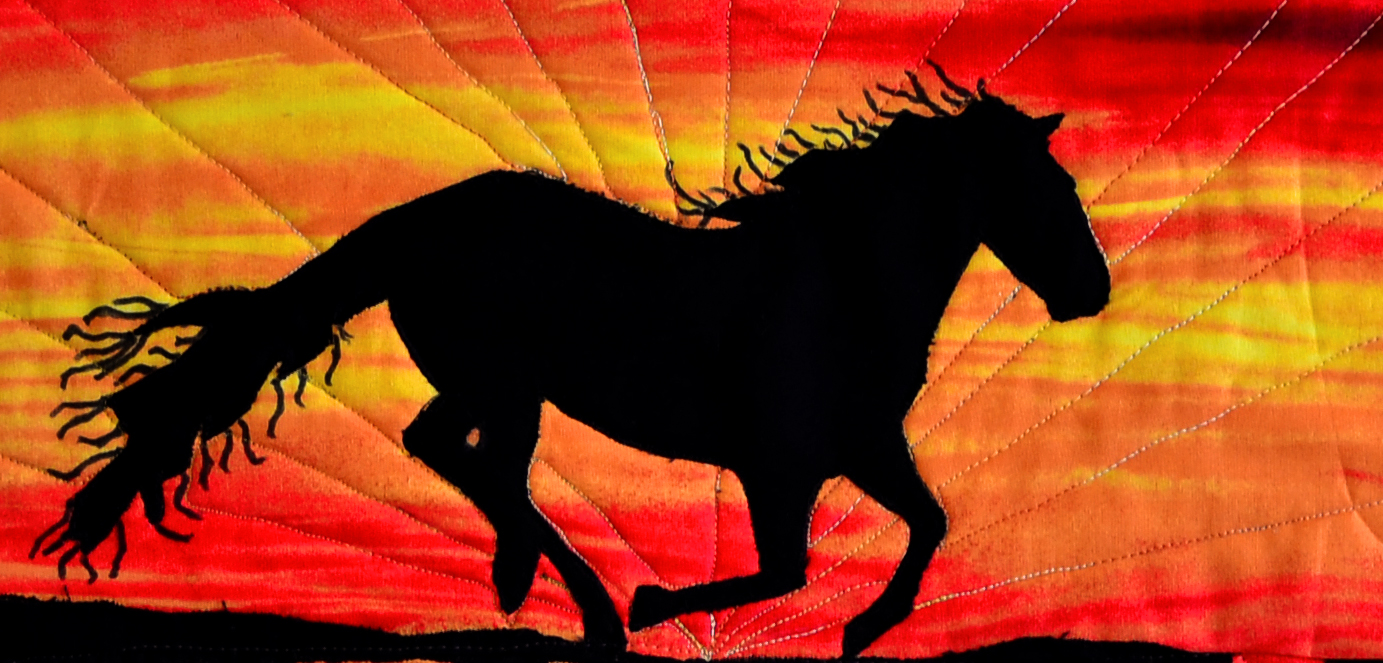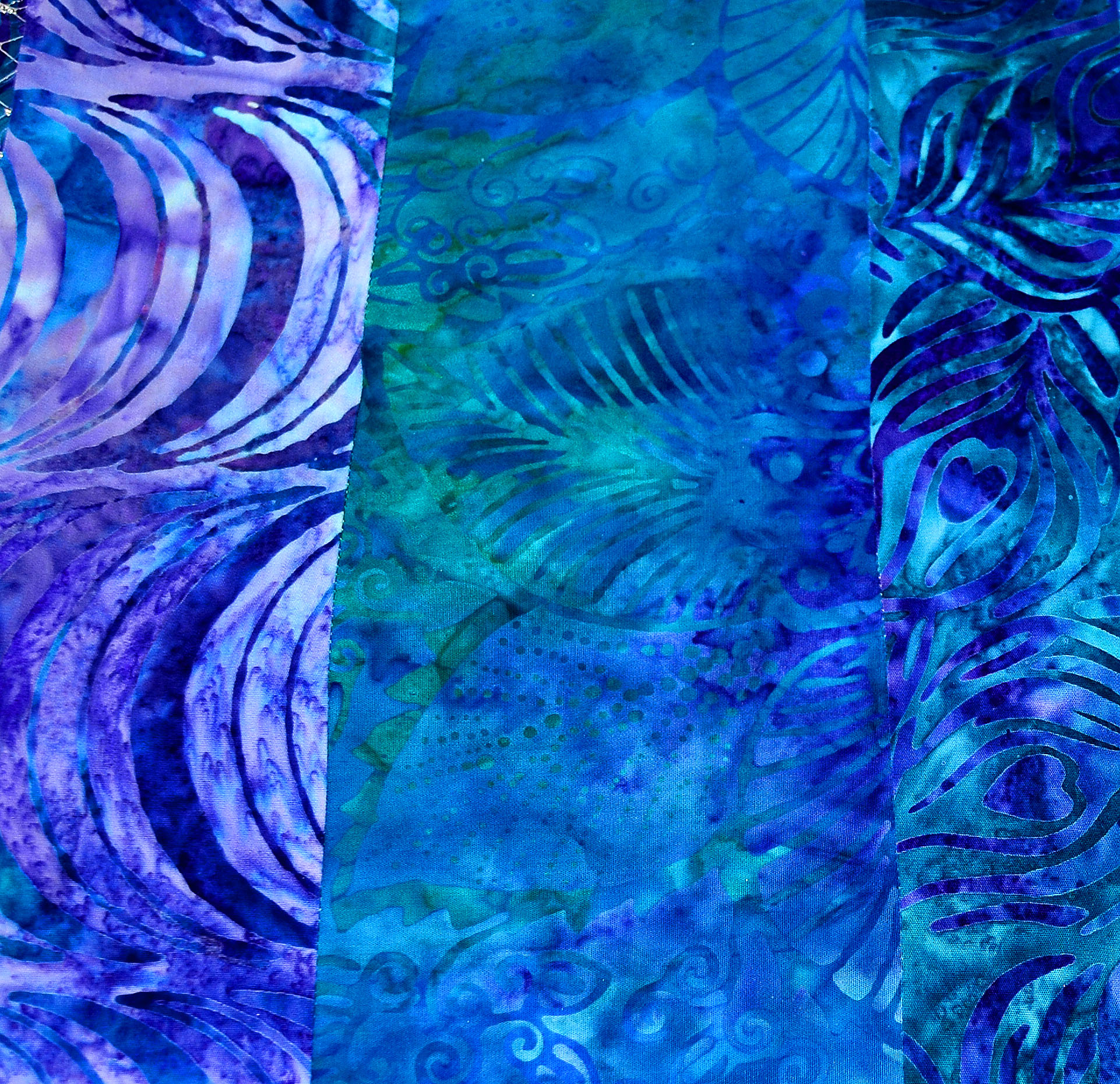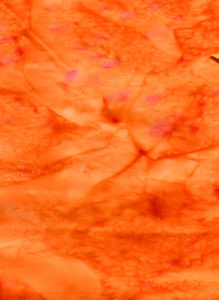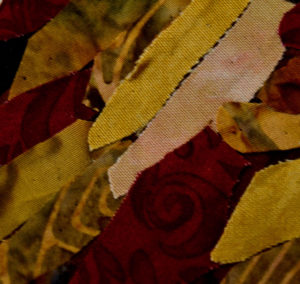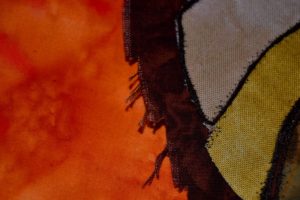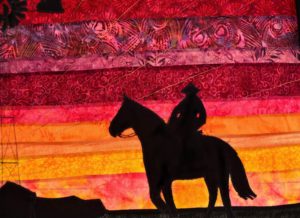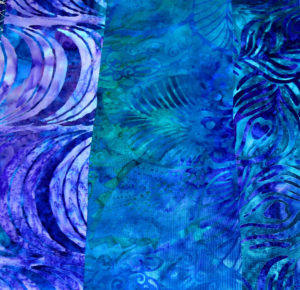Return of the Black Stallion
Remember the massive horse that charged across the theater of your imagination as a child? Now he’s back, forever running free on a sunset beach. Princess YellowBelly’s new black stallion quilt brings the incredible romance of the past together with quilting techniques.
Center your home with a framed picture of a black stallion quilted wall hanging.
You can purchase this item right now!
Powerfully Romantic
For anyone who ever loved the Black Stallion books or movies this is the chance to relive the experience every time you catch a glimpse of our nicely sized (17 ¾” X 22”) fabric art décor piece.
Princess YellowBelly and her friends used a variety of styles and quilting techniques to create this piece:
-
Silhouette Landscape Quilting
The scene is constructed with fiery orange and yellow quilting material to recreate a sunset beach.
A narrow strand of black material makes a solid beach, setting up the baseline for the black highlights and powerful drama that this piece entails.
-
Applique Quilting
Both the beach and the black stallion are separate pieces of black fabric that have been appliqued to the gorgeous sunset background of the quilt.
-
Fractured Quilting
This black stallion quilt features an extra bit of amazing! A reflection of the horse and sunset is perfectly captured in the water.
This is done using a technique called fractured quilted – where two or more images are cut apart and sewn back together to create the displacement optical illusion.
-
Fabric Marking Pen Enhancements
The black stallion quilt is made realistic by the addition of fabric pen markings on the horse’s mane and tail. These carefully replicated markings make the hair on the mane and tail appear to be truly flying free.
-
Tailored Quilting
Running Wild is quilted in two different sections – and styles.
The top, or single image, is quilted in sun rays and by outlining the black stallion, popping him out of the rest of the quilt. The bottom, or inverted fractured image, is quilted in uneven concentric circles to replicate rippling water and add to the magically realistic qualities of the black stallion quilt wall hanging.
One-of-a-Kind
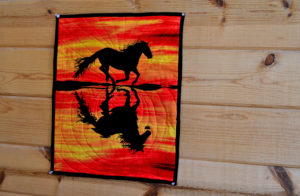
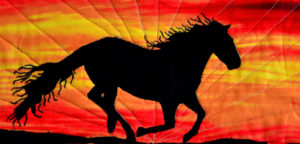
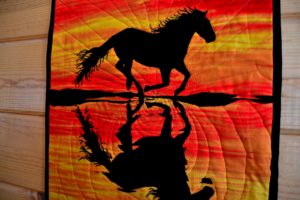
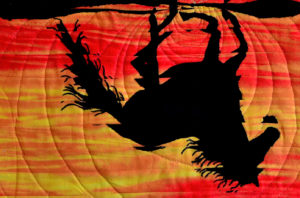
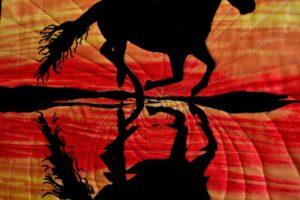
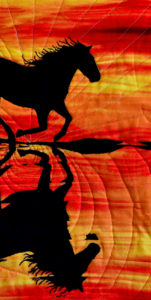
All in all the sunset & black stallion quilt “Running Wild” is a fabric art experience not to be missed.
You can purchase it on our Etsy.com seller platform – Lilies Of Grace – or read more specific product details below.
Bonus!
Princess YellowBelly and her friends (human and magical) love this piece so much that we’re turning it into a pattern and kit. This will soon be available, keep a sharp eye.
Princess YellowBelly’s black stallion Running Wild panel:
- Measures exactly 17 ¾” inches wide X 22 inches high
- Predominant colors are solid black, vibrant orange, fire red, pale yellow, and rich gold
- Running Wild shows a black horse running along a beach at sunset. His image is “reflected” in the water
- Is back with true black batik fabric (same as the image of the horse)
- Running Wild is tagged or named
- Weighs very little
- Folds into a surprisingly small and flat package
- Is a vividly realistic wall art panel
Sunset material is from a collection called “Tuscan Poppies Sunset” and is a batik-quality quilter’s fabric.
The black fabric is solid Kona fabric (sometimes known as true Amish black).
Running Wild is quilted with warm and natural quilter’s cotton batting.
Care & Cleaning
Running Wild is an easy-care piece.
- Recommended care and upkeep with a lint brush
- Machine wash (cool, delicate cycle with a gentle detergent) if needed
- Can be tumble-dried, although air-dry is recommended
- May be cool-ironed (cotton settings) to remove packing wrinkles. Safe to iron with water or spray-starch
Display Options
We use regular household thumbtacks to secure our fabric art panels for display. They hold the panel tight and fabric is self-healing, once the tacks are removed the holes will close up again.
If you would prefer to use a hanging or curtain rod to display Running Wild, we offer hanging sleeve options.
Hanging sleeves are only attached upon your order and your selection of your preferred choice –
- Top Hanging Sleeve for normal hanging
- Top & Bottom Hanging Sleeve if you would like to weight the panel as well
Hanging sleeves are made of the same material as the backing fabric, and are about four inches wide each (although this can be adjusted to custom requirements). They are attached under the binding seam line, and are secured with hand stitching to ensure that the seam won’t show through on the front of the panel.
If you would like to discuss customized options, please contact us directly!
Custom Orders
We are always happy to talk about a new piece with your ideas! If you have an idea you would like to see developed, or if you would like to have us make you something specifically please contact us.
You can talk to us at our Etsy.com shop – or you can use the contact form below to submit your questions & ideas.
Layaway
Sometimes the prices on our artwork can seem a little out-of-reach, which we understand! We try to charge very reasonable fees, but if you really want Autumn Rondelle, but don’t think you can afford it in one go, please contact us via the form at the bottom and request a custom layaway program.
Thanks for getting all the way to bottom of this piece! Please let us know what you think in the comments below, or contact us.
*Photographer’s Note: Due to the intense oranges and red of the background sunset fabric, Running Wild proved difficult to photograph accurately as the color confused the camera’s sensors.
While every effort was made to clearly capture the colors of this fabric art wall hanging, some color clarity was lost in the photographic process. The sunset-to-black ratio is much clearer and true-color than the photographs represent.

